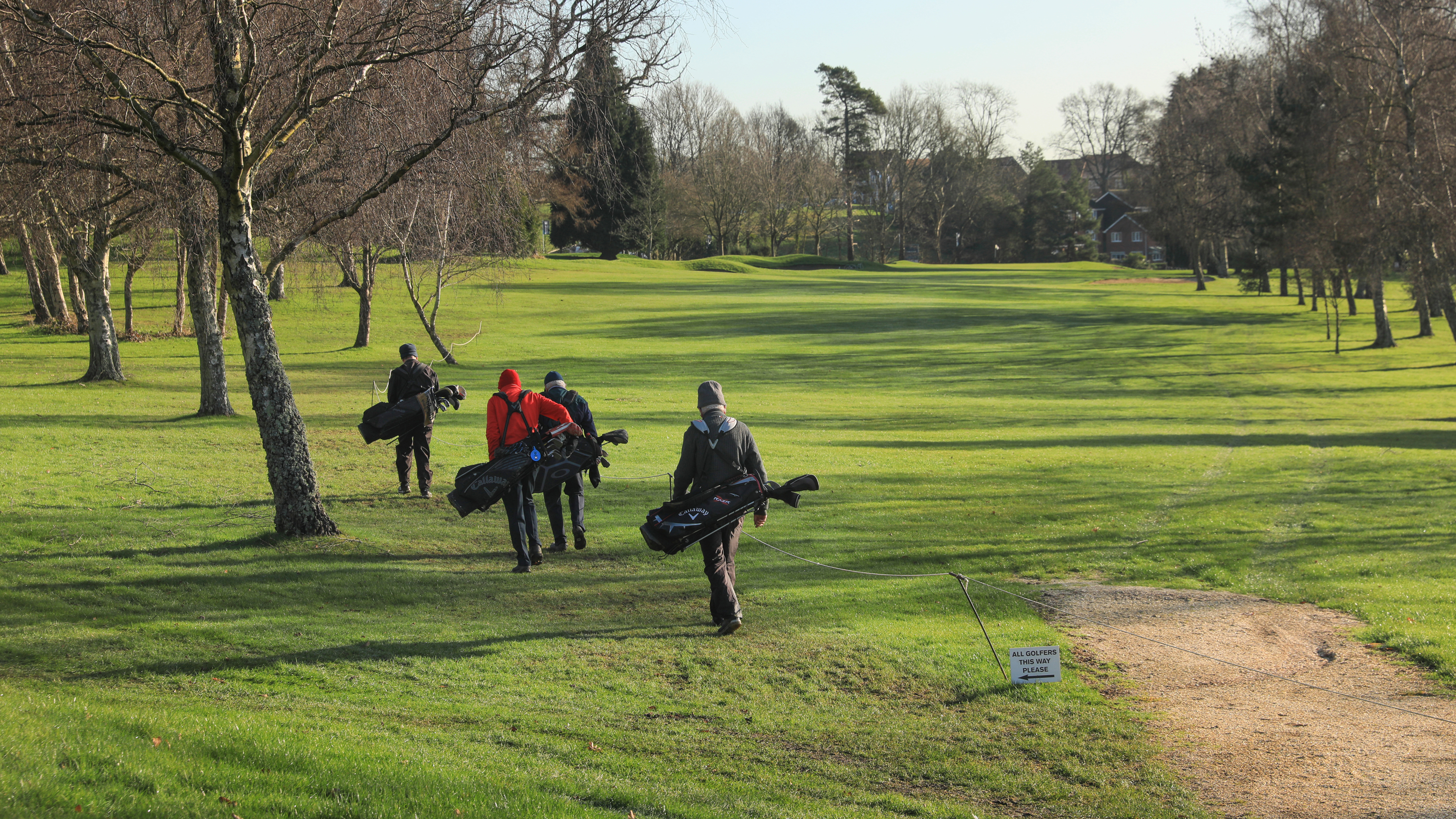Why Universal Golf Ball Rollback Is Like Using A Wrecking Ball To Crush An Ant
The universal rollback of the ball is an extreme solution to a niche problem within golf, and it’s not good news for amateurs.


I was initially quite surprised to learn The R&A and USGA were announcing, and have now announced a universal rollback of the golf ball, to be phased in from 2028. On reflection though, it was an inevitable conclusion to a protracted process, albeit a conclusion I feel will be disappointing for most amateur golfers.
Distance has been on the radar of the governing bodies for years and I’ve been following the debate for nigh on two decades. In 2018, The R&A and USGA launched a comprehensive Distance Insights Project which involved extensive review, research, testing and consultation. That led to an announcement in March this year of a proposed “Model Local Rule” (MLR) that could be used in elite events to ensure competitors play a limited-distance golf ball. Feedback was then sought on that proposal.
With so much work going into the project, I knew something happening was inevitable. Martin Slumbers told me, “Doing nothing is not an option,” when we met at the recent Asia Pacific Amateur Championship. But I must confess, I assumed that the “something” they would do would be to implement the MLR.
I had my issues with that suggestion as I have never liked the idea of using a different ball to those playing in The Open Championship or at Augusta National. In my opinion – everyone in golf should play by the same rules. The manufacturers were, unsurprisingly, also not keen on bifurcation but, as far as I’m concerned looking at what has happened now, it would have been the lesser of two evils.
Unfeasible

The MLR was never going to happen...
The R&A and USGA could have chosen to bludgeon ahead with the MLR but the manufacturers have been holding all the cards. The governing bodies will have likely gone to the golf ball makers and said – “Right, we want you to create two production lines for the premium balls you make. One at the old specifications, and another (for a relatively small number of balls) at the MLR specifications.” The manufacturers will have, most likely, quite simply said – “We think not.” It would be massively expensive for them to do it. Possibly unfeasibly expensive.
There were then just two options for The R&A and USGA from there – Keep things as they are or make the change universally. As mentioned, they’ve stated, “Doing nothing is not an option,” and they won’t have wanted to back down on that sentiment. Therefore, here we are, we’re all going to have to face up to hitting the ball a shorter distance – although not quite so much of a shorter distance compared with the MLR proposals. The governing bodies have had to compromise a little so as not to totally spoil our fun!
It's not really a problem at the very highest level of men’s pro golf, where they certainly don’t want for distance. 13-15 yards fewer off a 340 yard drive won’t kill them. It’s not so good for the average punter who struggles to clear the water from the tee on the 14th as it is. That five yards they tentatively suggest the average player will lose (I think that's a bit of an underestimation) could be the difference between scraping past the trouble and ending up wet!
Subscribe to the Golf Monthly newsletter to stay up to date with all the latest tour news, equipment news, reviews, head-to-heads and buyer’s guides from our team of experienced experts.
A Blow To Amateurs

Rory McIlroy is among those who have expressed support for a rollback, even when it was only going to affect elite golf. When it was suggested a universal rollback would occur, Rory took to social media to tell amateur golfers to stop complaining, effectively saying it wouldn’t make a blind bit of difference to them.
I think Rory was being a touch harsh on amateur golfers, particularly those whose principal strength is hitting the ball a decent distance. I’m in that camp – still clinging to the fringes of the campsite at least. My low handicap is principally protected by the fact I can hit the ball a good distance off the tee and so reach long par-4s and the odd par-5 in two. My short game is terrible, so I need to be up there and putting to have a chance of regularly making pars, (the occasional birdie.) If I’m going to reach a % fewer greens in regulation or better, I can only see my scores going up.
There are a couple of par-5s at my club that measure around the 520-yard mark. I can just about reach them in two with a Sunday best drive of 285 and an approach with a fairway wood of 235… Take 4% off my drive, as that’s roughly what it looks like I will be losing as per 2030... (so now 274) and off my second (now 226) – I'll be 20 yards short… Rather than putting for eagle, I’ll face a delicate pitch (not my strength) and will be struggling for par! This change will not be good news for me, I can tell you that for a fact Rory.
I’m sure, I’m not alone – How many of us can occasionally scrape it onto the front edge of that short par-4 at our home club? Maybe not anymore… That is going to reduce my enjoyment of golf.
And what about costs? I don’t know, but generally new research and development, new production processes mean added cost. I have a horrible feeling about who those costs will be passed on to…
Who Is This Really Targeting?

This guy for one!
Let’s face it, the vast majority of the 60+ million golfers on the planet don’t need to have their hitting distances curtailed. Figures from leading shot monitoring tech company Arccos, based on 20 million driver shots, suggest average amateur driving distance actually came down from 2018 to 2022. The average driving distance for men in 2018 was 226.4 yards and that reduced to 225.9 in 2022. It's similar for women. The average woman drove it 179 yards in 2018 but that was down to 177 yards in 2022.
The only people who are really out-hitting golf courses are the top-level professional men. It’s totally right that we can’t keep extending golf courses for the top male professionals (see that 8,000+ yarder for the South African Open) – Lengthening courses is not sustainable nor is it possible in many instances. Building new monster courses is not environmentally sound. But surely there are other ways to curtail the top dogs.
Back To Course Set-Up

Can't we have more bunkers like this?
I just don’t understand why tournaments can’t set up courses for the top male professionals so they don’t always reward super-long hitting. End the fairway at 300 yards, put in pot bunkers, narrow fairways and grow up the rough. I wrote after The Open about how Brian Harman displayed that when a course is set up correctly for top-level men’s tournament golf (as Royal Liverpool was) then a relatively short hitter can triumph by displaying different golfing skills, rather than simply long hitting.
I put that point to Martin Slumbers when we met in October. His response was, “I think it’s an abdication of responsibility to say, let’s do nothing with the golf ball and let’s just get everyone to change their golf courses.”
But we’d only be talking a very few courses – Just where top-level professionals play. Those venues tend to have a few quid don’t they? I really don’t think it’s unrealistic for the leading courses, ones that already, or aspire to, host pro competitions to make changes that would curtail hitting distances from the back pegs.
Consider the US Open where set-ups are famously challenging. Yes, long hitters often prevail (most elite male pros are long hitters,) but they must display other skills as well to get the job done, think of Matt Fitzpatrick's bunker shot on the 18th in 2022. They need to be able to scramble and (normally) deal with firm greens. When I was at Royal Melbourne for the Asia Pacific Amateur Championship in October, the course was so firm that only perfect shots were holding the greens and the winning score was one-over-par - and it wasn't one of the obviously bigger hitters who prevailed (Jasper Stubbs.)
I just think it is possible to make any hole ask for more than just power - a combination of hazards (deeper bunkers - why can't bunkers be deeper?) added at driving distance, narrower fairway, more punishing rough and less accessible pin position... It shouldn't be impossible should it? If a long hitter can also deal with those circumstances, then fair play to them. And, if some courses remain forgiving then we just see low winning scores in those tournaments. What’s the big deal?
A Required Equipment Change, But It Won’t Be The First Time

It won't be the first time equipment rules have changed
Things aren’t going to change immediately with regards the golf ball. In fact, we amateurs have up until 2030 until we’ll be required to make the switch. Boy, it’s going to be tough to monitor. When we made the switch to the larger (American) golf ball back in the last century, it was very easy to spot if someone was not “playing ball” – sorry. But when it’s a subtle difference to the make-up of the ball rather than its size, how will anybody know? Will the new ones have a big “C” for conforming printed on them? How many people will simply stock up on the old balls and continue to use them? Having said that, we got used to the new big ball, and we will, of course, get used to these new balls that don't travel so far.
What should be remembered, too, is this is not the first time we’ve had a limitation to distance in golf. Back in the early 2000s, The R&A and USGA placed a limit on the coefficient of restitution (COR) – basically a spring-like effect within clubfaces. In 2005, they published a list of Conforming Driver Heads… Anyone who had a non-conforming driver was no longer able to use it in competition. Not great news if you’d shelled out hundreds for what you believed was a state-of-the-art driving weapon!
I think the universal ball rollback is the equivalent of using a wrecking ball to crush an ant though. To alter the game for every golfer on the planet to (slightly) curtail a few bombers at the very top of the men’s game, seems an unnecessary overkill. I love watching the big boys hit it miles, but not always – Some holes should require more strategy. I don’t want courses getting longer either, that is not the way forward… Did I mention pot bunkers and longer rough at 300 yards out?

Fergus is Golf Monthly's resident expert on the history of the game and has written extensively on that subject. He has also worked with Golf Monthly to produce a podcast series. Called 18 Majors: The Golf History Show it offers new and in-depth perspectives on some of the most important moments in golf's long history. You can find all the details about it here.
He is a golf obsessive and 1-handicapper. Growing up in the North East of Scotland, golf runs through his veins and his passion for the sport was bolstered during his time at St Andrews university studying history. He went on to earn a post graduate diploma from the London School of Journalism. Fergus has worked for Golf Monthly since 2004 and has written two books on the game; "Great Golf Debates" together with Jezz Ellwood of Golf Monthly and the history section of "The Ultimate Golf Book" together with Neil Tappin , also of Golf Monthly.
Fergus once shanked a ball from just over Granny Clark's Wynd on the 18th of the Old Course that struck the St Andrews Golf Club and rebounded into the Valley of Sin, from where he saved par. Who says there's no golfing god?